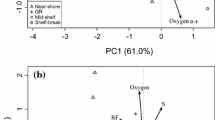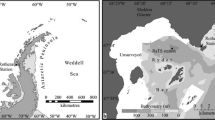Abstract
We performed a series of seawater culture experiments on surface mixed layer samples during the spring phytoplankton bloom in the North Atlantic Ocean. Diluted (20% unfiltered + 80% 0.22 μm filtered) and untreated “whole” seawater samples were incubated up to 40 hour and sampled periodically for cell numbers, biovolume, and incorporation of 3H-thymidine and -leucine. Abundance and biovolume increased exponentially at similar rates in diluted and whole samples, suggesting that removal by bacteriovores was low compared with growth. The exponential increase in biovolume was due to increases in cell numbers and mean cell volume. Generation times (i.e., 0.693/μ) averaged 36–53 hour in these surface (10 m) samples. Ninety percent of the tritiated thymidine incorporation (TTI) into cold trichloroacetic acid-insoluble cell fractions was recovered after extraction with NaOH and phenolchloroform, indicating that catabolism of thymidine and its appearance in RNA or protein was very low. The percentage of thymidine recovered in DNA did not change over the 40 hour of incubation and was the same as in water column samples. Rates of thymidine and leucine incorporation also increased exponentially. Incorporation rates tended to increase more rapidly than cell numbers or biovolume, though the differences were not significantly different, due to the small number of samples and variability over the time courses. Differential rates of increase in cellular properties during growth might indicate a lack of coupling between incorporation and production over time scales of hours-days. This in turn may reflect unbalanced growth of bacterial assemblages, which is an adaptation to variable conditions in the upper ocean in this season. Nonequality of rate constants for cells and incorporation yields conversion factors that are either higher or lower than would be calculated from balanced growth (i.e., rates of increase in numbers and incorporation rates equal), depending on the calculation approach chosen. An alternative approach to calculating conversion factors (the modified derivative approach) is proposed, which is insensitive to differential rates of increase of abundance and incorporation.
Similar content being viewed by others
References
Ammerman JW, Fuhrman JA, Hagstrom A, Azam F (1984) Bacterioplankton growth in seawater: I. Growth kinetics and cellular characteristics in seawater cultures. Mar Ecol Prog Ser 18:31–40
Baldwin WW, Bankston PW (1988) Measurement of live bacteria by Nomarski interference microscopy and stereologic methods as tested with macroscopic rod-shaped models. Appl Environ Microbiol 54:105–109
Bjørnsen PK, Kuparinen J (1991) Determination of bacterioplankton biomass, net production and growth efficiency in the southern Ocean. Mar Ecol Progr Ser 71:185–194
Brittain AM, Karl DM (1990) Catabolism of tritiated thymidine by aquatic microbial communities and incorporation of tritium into RNA and protein. Appl Environ Microbiol 56(5):1245–1254
Chin-Leo G, Kirchman DL (1990) Unbalanced growth in natural assemblages of marine bacterioplankton. Mar Ecol Progr Ser 63:1–8
Christian RR, Hanson RB, Newell SY (1982) Comparison of methods for measurement of bacterial growth rates in mixed batch cultures. Appl Environ Microbiol 43:1160–1165
Coveny MF, Wetzel RG (1988) Experimental evaluation of conversion factors for the 3H-thymidine incorporation assay of bacterial secondary productivity. Appl Environ Microbiol 54:2018–2026
DeLong EF, Wickham GS, Pace NR (1989) Phylogenetic stains: Ribosomal RNA-based probes for the identification of single cells. Science 243:1360–1363
Ducklow HW (1986) Bacterial biomass in warm core Gulf Stream ring 8213: Mesoscale distributions, temporal changes, and production. Deep Sea Res 33:1789–1812
Ducklow HW (1992a) Bacterioplankton distributions and production in the northwestern Indian Ocean and Gulf of Oman, September, 1986. Deep-Sea Res (in press)
Ducklow HW (1992b) Factors regulating bottom-up control of bacterial biomass in open ocean plankton communities. Ergebn Limnol 37:207–217
Ducklow HW, Hill SM (1985a) The growth of heterotrophic bacteria in the surface waters of warm core rings. Limnol Oceanogr 30:239–259
Ducklow HW, Hill SM (1985b) Tritiated thymidine incorporation and the growth of heterotrophic bacteria in warm core rings. Limnol Oceanogr 30:260–272
Ducklow HW, Carlson CA (1992) Oceanic bacterial production. Adv Microb Ecol 12:113–181
Ducklow HW, Kirchman DL, Quinby HL, Carlson CA, Dam HG (1991) Response of bacterioplankton to the spring phytoplankton bloom in the eastern North Atlantic Ocean. Deep-Sea Res (in press)
Fuhrman JA, Azam F (1980) Bacterioplankton secondary production estimates for coastal waters of British Columbia, Antarctica, and California. Appl Environ Microbiol 40:1085–1095
Fuhrman JA, Bell TM (1985) Biological considerations in the measurement of dissolved free amino acids in seawater and implications for chemical and microbiological studies. Mar Ecol Prog Ser 25:13–21
Hobbie JE, Daley RJ, Jasper S (1977) Use of Nucleopore filters for counting bacteria by fluorescence microscopy. Appl Environ Microbiol 33:1225–1228
Hollibaugh JT (1988) Limitation of the [3H]thymidine method for estimating bacterial productivity due to thymidine metabolism. Mar Ecol Progr Ser 43:19–30
Ivanov MV (1955) The method for estimation of bacterial biomass in the water body. Mikrobiologiya 24:79–89 (English translation)
Kirchman DL (1990) Limitation of bacterial growth by dissolved organic matter in the subarctic Pacific. Mar Ecol Progr Ser 62:47–54
Kirchman DL, Hoch MP (1988) Bacterial production in the Delaware Bay estuary estimated from thymidine and leucine incorporation rates. Mar Ecol Prog Ser 45:169–178
Kirchman DL, Ducklow HW, Mitchell R (1982) Estimates of bacterial growth from changes in uptake rates and biomass. Appl Environ Microbiol 44:1296–1307
Kirchman DL, K'nees E, Hodson R (1985) Leucine incorporation and its potential as a measure of protein synthesis by bacteria in natural waters. Appl Environ Microbiol 49:599–607
Kirchman DL, Murray RE, Hodson RE (1986) Rates of DNA and protein synthesis by heterotrophic bacteria in aquatic environments: A comparison between the thymidine and leucine approaches. Proc IV Int Symp Microbial Ecology, Ljubljana, pp 631–637
Kirchman DL, Keil RG, Simon M, Welschmeyer NA (1991) Biomass and production of heterotrophic bacterioplankton in the oceanic subarctic Pacific (in press)
Kjelleberg S, Hermannsson M, Marden P (1987) The transient phase between growth and non-growth of heterotrophic bacteria, with emphasis on the marine environment. Ann Rev Microbiol 41:25–49
Kramer JG, Morris I (1990) Macromolecular bases of growth regulation in marine Synechococcus sp. WH7803. Arch Microbiol 154:286–293
Landry MR, Hassett RP (1982) Estimating the grazing impact of marine micro-zooplankton. Mar Biol 67:57–70
Li WKW, Dickie PM, Harrison WG, Irwin BD (1992) Biomass and production of bacteria and phytoplankton during the spring bloom in the western North Atlantic Ocean. Deep-Sea Res (in press)
Pedrós-Alió C, Newell SY (1989) Microautoradiographic study of thymidine uptake in brackish waters around Sapelo Island, Georgia, USA. Mar Ecol Progr Ser 55:83–94
Riemann B, Bjørnsen PK, Newell SY, Fallon R (1987) Calculation of cell production of coastal marine bacteria based on measured incorporation of [3H]thymidine. Limnol Oceanogr 32:471–476
Riemann B, Bell RT, Jørgensen NOG (1990) Incorporation of thymidine, adenine and Ieucine into natural bacterial assemblages. Mar Ecol Prog Ser 65:87–94
Sieracki ME, Verity PG, Stoecker DK (1992) Plankton community response to sequential silicate and nitrate depletion during the 1989 North Atlantic Spring Bloom. Deep-Sea Res Special NABE Volume (in press)
Tremaine SC, Mills AL (1987) Tests of the critical assumptions of the dilution method for estimating bacterivory by microeucaryotes. Appl Environ Microbiol 53:2914–2921
Weisse T, Scheffel-Moser U (1991) Uncoupling the microbial loop: Growth and grazing loss rates of bacteria and heterotrophic nanoflagellates in the North Atlantic. Mar Ecol Prog Ser 71:195–205
Wicks RJ, Robarts RD (1987) The extraction and purification of DNA labelled with [methyl-3H]thymidine in aquatic bacterial production studies. J Plank Res 9:1167–1181
Wicks RJ, Robarts RD (1988) Ethanol extraction requirement for purification of protein labeled with [3H] Ieucine in aquatic bacterial production studies. Appl Environ Microbiol 54(12):3191–3193
Wikner JF, Rassoulzadegan F, Hagström A (1990) Periodic bacteriovore activity balances bacterial growth in the marine environment. Limnol Oceanogr 35:313–324
Wright RT, Coffin RB (1984) Factors affecting bacterioplankton density and productivity in salt marsh estuaries. In: Klug MJ, Reddy CA (eds), Current perspectives in microbial ecology. American Society for Microbiologists, Washington, DC, pp 485–494
Author information
Authors and Affiliations
Rights and permissions
About this article
Cite this article
Ducklow, H.W., Kirchman, D.L. & Quinby, H.L. Bacterioplankton cell growth and macromolecular synthesis in seawater cultures during the North Atlantic Spring Phytoplankton Bloom, May, 1989. Microb Ecol 24, 125–144 (1992). https://doi.org/10.1007/BF00174450
Received:
Revised:
Issue Date:
DOI: https://doi.org/10.1007/BF00174450




